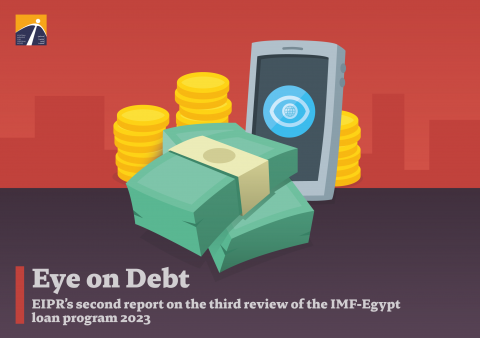Eye on Debt: EIPR’s second report on the third review of the IMF-Egypt loan program 2023
More inflation…more pain inflicted on the people of Egypt
After a downward trend in previous months, Egypt's inflation rates rose again in August and September. The rise was driven by the government's continued implementation of the IMF program's measures, most notably the hike in energy and electricity prices.
Following the postponement of the fourth review of the IMF loan to Egypt for the second time from early October to November of this year, and ahead of the annual meetings of the International Monetary Fund (IMF) and the World Bank currently underway in Washington, in which EIPR is participating, President Abdel Fattah al-Sisi said that if the measures agreed upon with the IMF will increase the pressure on Egyptians unbearably, they should be reconsidered. At the same time, according to an unnamed government official speaking to CNN Arabic, the Egyptian government has reached out to the IMF to finalise an agreement on implementing the economic reforms agreed upon in the loan program, “but over a longer period of time.” The comments came days after the government raised fuel prices for the third time this year in October, threatening a new wave of price hikes due to the impact of energy on many sectors of the economy, especially transportation.
The release of Eye on Debt's second report on the 2023 loan coincides with the annual meetings of the World Bank and Fund in Washington. In the report, EIPR monitors the measures that were agreed upon in the third review of the loan, what was actually implemented among those measures and analyzes the socio-economic impacts of implementing the IMF's conditions.
During the third review, which was approved in late July, the IMF reaffirmed a number of key conditions for the Extended Credit Facility program, the most important of which is the continued maintenance of Egypt's flexible exchange rate. Since mid-May, the CBE has allowed the pound a greater margin of movement against the dollar, with the exchange rate falling from a low of EGP 46.7 per dollar to a high of EGP 49.2 per dollar, representing a movement of around 5%, a range of fluctuation that fulfills the IMF's condition of relative exchange rate flexibility.
The biggest rate move followed the waves of selling that hit global stock exchanges at the beginning of August 2024, which prompted the exit of a lot of hot money. The government estimated the figure to be only about 7-8% of foreign ownership of Egyptian treasury bills, which means the exit of 2.5-3 billion dollars in a few days. The CBE needed to move the exchange rate slightly, but in the future, if the exit waves are larger, the CBE will likely have to lower the exchange rate further.
This is the crux of the issue in managing the current currency crisis. Despite the large cash inflows from the sale of assets such as Ras al-Hikma, the risk of hot money exiting due to a global or domestic crisis is still high, and if it happens, it will lead to a new devaluation of the exchange rate. The IMF did not attempt to address this issue in its conditions, by warning or advising the government against relying too much on hot money, as this would require measures to control these flows – which the IMF generally does not encourage, in fact the IMF always advises against such controls in times of crisis.
The report analysing the third periodic review of the agreement provides us with a snapshot of the progress of the different dimensions of Egypt's program with the IMF, as well as the conditions and risks related to the program implementation. EIPR is keen to provide this critical reading periodically, in its series of reports entitled “Eye on Debt”, which focus on understanding the different aspects of the conditionalities of the program as well as providing observations on these aspects and policy alternatives that take into account the socio-economic perspective.




